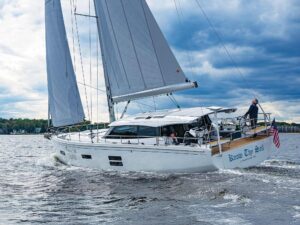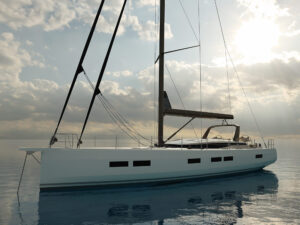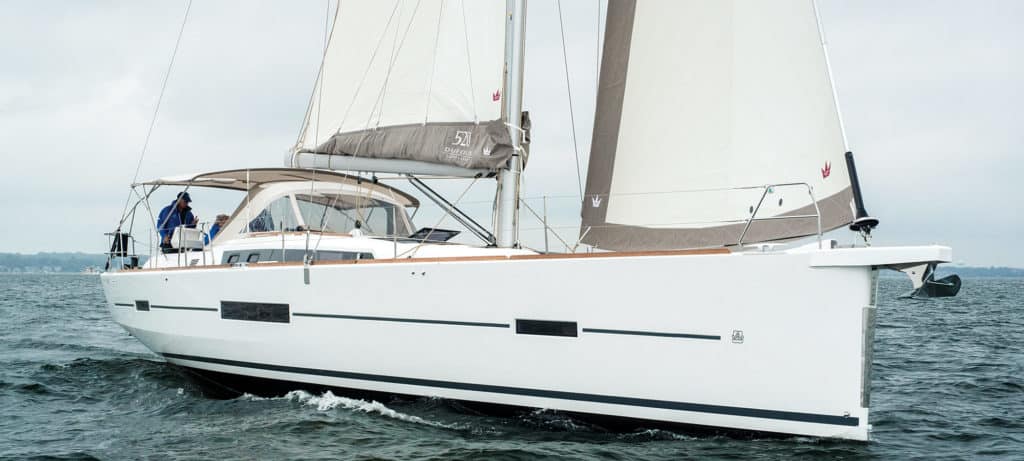
After spending more than an hour inspecting the new Dufour 520 during the U.S. Sailboat Show in Annapolis, Maryland, last fall and then sailing the boat in a decent breeze in the days following, our Boat of the Year judges named the queen of the company’s Grand Large line Best Full-Size Cruiser 50 to 54 feet. They might just as easily have named the Umberto Felci-designed French production-built sailboat Best Value Among Peers or Most Versatile, had those categories been an option. It was a boat that quickly rose to the top as our independent team of experts reviewed their notes and picked this year’s fleet of winners. “This one hits it for me in this class,” said Ed Sherman, citing the boat’s sailing performance — 5.5 to 6 knots in 9 to 11 knots of wind — the ergonomics of the cockpit, and the layout below, where the galley is located athwartships at the main bulkhead, leaving the beamiest part of the saloon dedicated to living and entertaining space.
His colleague Tim Murphy quickly agreed, pointing out the boat’s several “Transformer-like” attributes that are easily toggled between sailing and living modes. Starting topside aft, an enormous, two-level swim platform folds up when on the move to secure the cockpit and provide seating for the helmsman at either of the twin wheels. At anchor, with the platform down, it gives the chef a place to stand when using the outdoor sink and grill. A drawer-style fridge under the drop-leaf teak cockpit table completes the outdoor galley. Forward of the wheels, the crew can relax against the cockpit coamings on bench seats while underway; at anchor, panels fold up to turn those seats into sun lounges or outdoor bunks for sleeping under the stars.
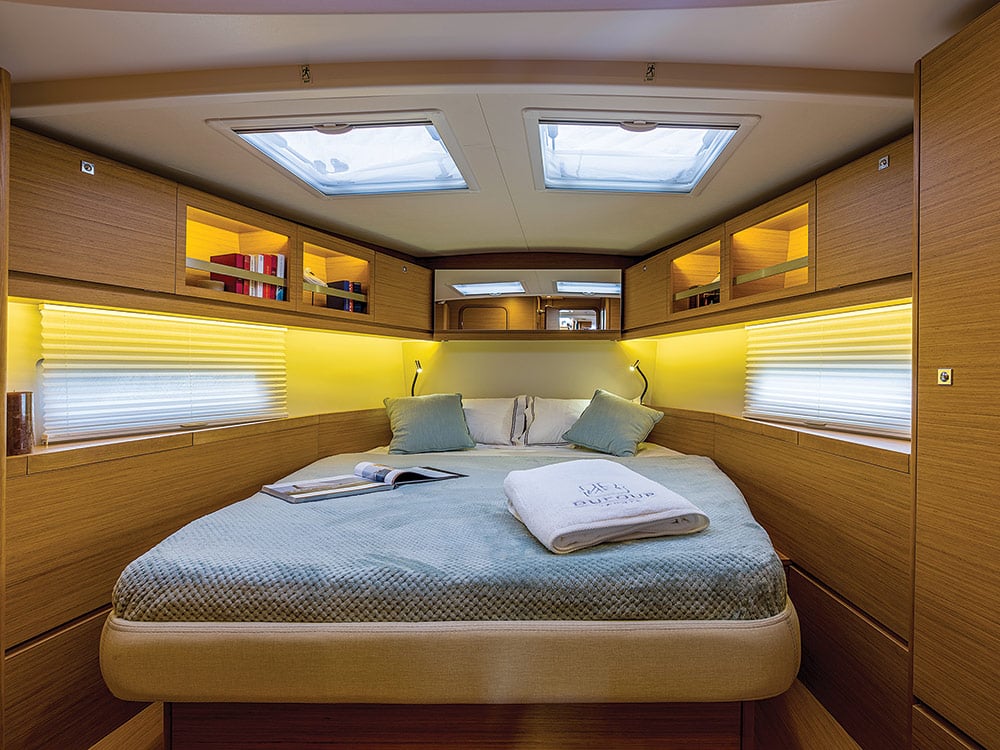
Numerous deck hatches, including two over the queen-size island berth in the owners stateroom forward — not to mention ports set into the hull — let natural light and fresh air pour into the 520’s interior. Photo courtesy of Dufour Yachts
Down below, to starboard, at the foot of the companionway stairs, a desk to port slides ahead to become a forward-facing nav station while underway. It can also be tilted, depending on the tack you’re on. When in port, the desk can be pushed aft and turned into an end table, and a fill-in cushion creates a full-length settee or extra sea berth.
Opposite is a dining table that, with the flip of a switch, can be lowered for cocktails or coffee, raised for dining or folded open to feed the whole crew. Outboard of it, there’s a second full-length settee; amidships and aft, seats lock into the floor, and their backs provide much-appreciated handholds when underway.
Numerous overhead hatches let in light and air, and ports in the hull let you enjoy the view when seated below. Owners can choose between a darker Moabi interior wood or light oak, which was used on the boat we sailed.
And then there are the layout options. There are four to choose from: three cabins and three heads; three cabins, two heads and a Pullman berth with bunks; four cabins and four heads, thanks to a panel that splits the large owners cabin forward in two; or four cabins, three heads and a Pullman berth that, all told, will sleep up to 12. In all cases, the double berth in the port cabin aft is built to be split into two singles — a convenient place to stash the grandkids.
“All these things adapt to the different ways that people use boats,” noted Murphy.
If it were my boat, I’d use it to sail. All the time.
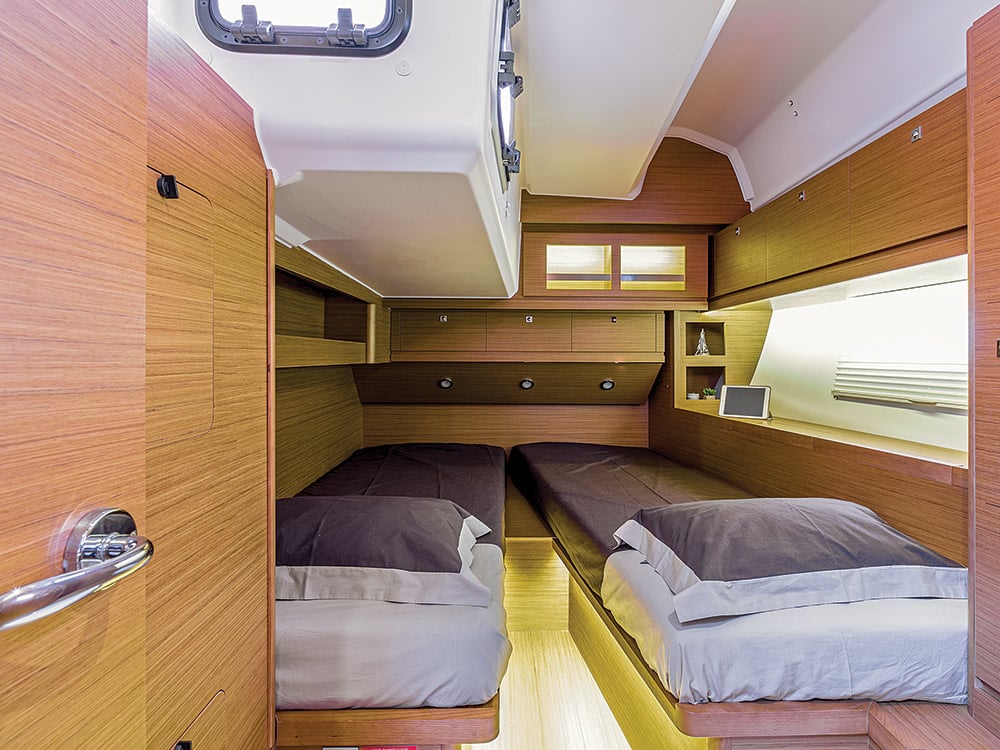
I took the wheel as we worked our way upwind, and the Lewmar chain-and-cable steering felt smooth as silk as I sat to leeward and leaned against the stainless-steel pushpit. The 520’s double-ended German-style mainsheet arrangement meant I had control of the mainsail at my fingertips on either tack, and I had no difficulty coming about unassisted and cranking in the slightly overlapping genoa, thanks to electric Lewmar winches.
Bearing off on a reach, we found the speed dropped a bit, as is often the case with the smaller headsails in use today. The boat, though, has a composite bowsprit for flying off-wind sails, definitely an option I’d go for.
My one peeve on the 520 was the location of the engine panel and throttle, placed near the cockpit sole and aft under the rear seat, making the former hard to read and the latter awkward to reach. BOTY judge Bill Bolin also brought up the fact that sheets and halyards all were of the same color. He’d have preferred different hues to make it easier for new crew to quickly identify which line to tug. Installing labels would be a suitable solution.
Construction of the 520 is straightforward. Its hull is hand-laid solid fiberglass below the waterline and PVC-cored above, as is the deck. Polyester resin is used throughout, and E-glass is added to the layup to reinforce high-load areas such as around the chainplates. A structural grid is glued and tabbed into the hull.
An owner can opt for either a shoal-draft (6 feet 4 inches) or standard keel (7 feet 2 inches), and a standard (70 feet 2 inches) or adventure package mast (74 feet 9 inches) that allows for a bigger sail plan. There are also two options for engines: a 75 hp Volvo with saildrive, or a 110 hp Volvo with shaft drive. The boat we tested had the smaller engine, but still it pushed us along at 9.2 knots wide open.
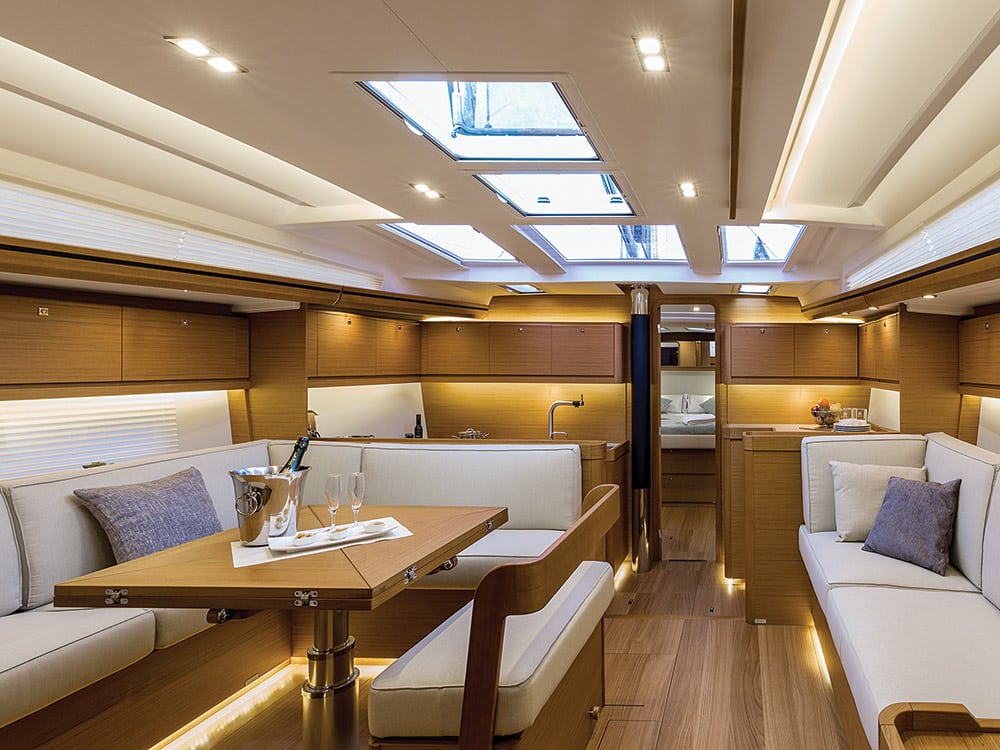
Finally, in their deliberations, the judges cited the 520’s cruising attributes. Although the boat was described as blue-water-capable, the builder said its design wasn’t necessarily intended for living aboard. Still, it carried the most fuel (118 gallons) and water (180 gallons) in its category.
A base model sells for just over $400,000; with options such as a full suite of Raymarine electronics and air conditioning, the boat we sailed was priced closer to $500,000, but still, it was $100,000 or so less than the competition.
Value, adaptability, fine sailing performance: Like our judges, I found there was a lot to enjoy on the Dufour 520.
Specifications
Dufour 520
| LENGTH OVERALL | 50’10” (15.49 m) |
| WATERLINE LENGTH | 45’2” (13.77 m) |
| BEAM | 15’9” (4.8 m) |
| DRAFT (Standard/shoal) | 7’6”/6’4” (2.29/1.93 m) |
| SAIL AREA | 1,085 sq. ft. (100.8 sq. m) |
| BALLAST (standard/shoal) | 9,259/9,567 lb. (4,200/4,340 kg) |
| DISPLACEMENT | 33,609 lb. (15,245 kg) |
| BALLAST/DISPLACEMENT | 0.28 |
| DISPLACEMENT/LENGTH | 163 |
| SAIL AREA/DISPLACEMENT | 16.7 |
| WATER | 180 gal. (681 l) |
| FUEL | 118 gal. (447 l) |
| HOLDING | 14 gal. (53 l) |
| MAST HEIGHT (standard/adventure) | 70’2”/74’9” (21.39/22.78 m) |
| ENGINE | 75 hp Yanmar, saildrive |
| DESIGNER | Umberto Felci |
| Price | $480,000 |
Dufour Yachts
352-871-0362
dufour-yachts.com



